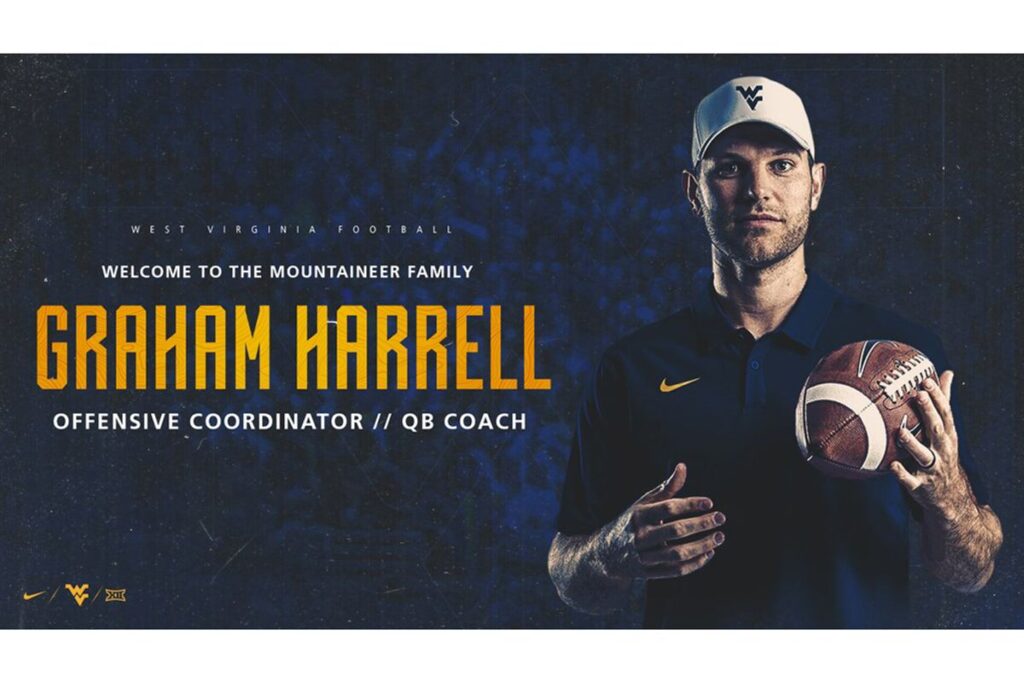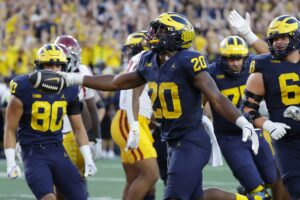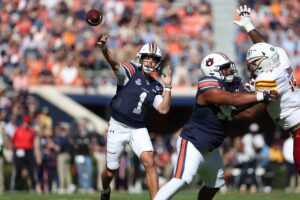Remaking West Virginia’s Identity with Graham Harrell
A few weeks ago, West Virginia introduced Graham Harrell as its new offensive coordinator. Harrell, of course, has not yet had a chance to run practices with his new team, but he certainly has plans for their direction. In his first remarks to West Virginia fans about a week ago, Harrell made something abundantly clear. He brings with him confidence and lofty expectations. Indeed, he talked repeatedly about “holding the [offensive players] accountable” to the staff’s expectations. What are they? Well, he said, “if we touch the ball, we expect to score.” Given last season’s struggles, then, it’s safe to say the staff is remaking West Virginia’s identity with Graham Harrell.
Expectations to Score
Before jumping into what the Mountaineers’ new identity might look like under Harrell, we want to unpack his proclamation. Again, he said, “if we touch the ball, we expect to score.” He dove a bit deeper and said, even if we’re up by two to three scores and get the ball with two minutes left in the half, we have to build that mentality. We expect to score then, too.
Indeed, even during the offensive “golden” years of the Dana Holgorsen era, fans expressed frustration at Holgorsen’s tendency to throttle it back a bit when they were up big. Two examples bear mention.
Giving Games Away
Think back to 2014. After starting the season 2-2, the Mountaineers gained some momentum after dismantling fourth-ranked Baylor at home and following it up with a win at Oklahoma State. West Virginia entered a home tilt with tenth-ranked TCU ranked twentieth themselves. TCU led by one point for just under two-and-a-half minutes in that game. West Virginia then built a nine-point lead four seconds into the final quarter. Holgorsen, however, played the rest of the game conservatively, content to run out some clock and play it safe. As time expired, TCU hit a game-winning field goal, winning by a single point.
Now, think back to 2018. Ranked seventh in the nation after an 8-2 start, West Virginia came out swinging against Oklahoma State. Going into the half, the Mountaineers built a 31-14 lead in Stillwater. Again, the play-calling became much more conservative on WVU’s side, even as the Cowboys whittled away at the lead. Finally, with 42 seconds left in the game, the Cowboys took their first lead of the game, and they ended up winning by that score, 45-41.
Losing All Identity
It is, of course, no secret that the West Virginia offense lost the vast majority of its firepower after that season, leaving Head Coach Neal Brown with a significant rebuild. Brown wanted to build the team into a power run unit capable of controlling the clock and, thus, the final outcome. Defensively, his staff built a unit capable of doing its part of the job. That said, the offense still needed to score.
Looking back at the last 21 seasons beginning with the Rich Rodriguez era, the Mountaineers have scored fewer than 30 points per game nine times. One of those came in Rodriguez’ first season, with the second in his third. One other came during Holgorsen’s lone losing season. The other three came in successive seasons.
During the Bill Stewart era, West Virginia failed to score 30 points a game in each of his three seasons. This should tell us something. Even though Stewart’s Mountaineers finished 9-4 every year, fans grew tired of watching a lackluster offense, especially one with a weapon as potent as Noel Devine. Jeff Mullen‘s offense scored 25 points a game on average during that three-year period.
It is not hard to understand, in that context, why Mountaineers fans are extremely disgruntled with a team that averages just 24 points per game over the last three seasons. First, when Mullen outscores you, well, that is a very low bar. Second, coupling a boring offense with a 17-18 record over three seasons is a recipe for discontent.
Comparing Offensive Numbers
In the 2021 season, looking at WVU’s 11 games against Power Five opponents, the numbers look bad. West Virginia’s offense had 128 possessions (excluding those that ended halves). They scored on just 48 of them (38%). The Mountaineers turned the ball over on 23 of them; they missed field goals on four of them, and they punted 53 times. When you punt more often than you score, it is hard to keep fans in the seats.
Thus, when a new coordinator says that his identity will center around a premise that “we expect to score” every time they have the ball, well, that thought process is certainly welcome. In his six years as offensive coordinator at two destinations, Harrell’s teams average just under 32 points per game. In this most recent season, arguably his worst offensive output, USC scored on 47% of their possessions. Over the course of his career, that number is closer to 60%. Both offer vast improvements over the current offensive output in Morgantown.
Perhaps better yet, Harrell has done this with young quarterbacks. At North Texas, he started with Mason Fine, a two-star quarterback, and a true freshman. In his second season, Fine completed 63% of his passes for over 4,000 yards (just shy of eight per attempt) and threw 31 touchdowns to 15 interceptions. At USC, he started with a three-star quarterback, Kedon Slovis, who was forced into starting duties due to JT Daniels‘ injury against Fresno State. Slovis finished the season completing 72% of his throws with over 3,500 yards (just shy of nine per attempt) and threw 30 touchdowns to just nine interceptions.
How Harrell Might Remake the Offensive Identity
In some ways, Harrell certainly has his work cut out for him in remaking West Virginia’s identity. That said, his plan is relatively simple. He intends to use Spring camp to figure out what the offense does and what the individual players, including the quarterbacks, do well. Based on that, he will then offer the players the points that they need to improve upon in Summer. In the Fall, he will then find ways to translate the things the team does best to on-field execution.
At root, Harrell is an “air raid” coordinator. His ties to Mike Leach run deep. That said, Harrell is quick to note that “air raid” doesn’t look the same in every iteration. Instead, it really is basic philosophy. Harrell paraphrases the philosophy as this: “You can’t be great at everything.” Instead, he adds, “We gotta have an identity . . . and be really good at who we are.” He very much intends to keep the offense simple and focus on its best aspects.
Harrell certainly has some tools to work with. We will offer more detailed breakdowns of his position groups in our pre-Spring positional breakdown series. That said, we watch intently to see how Harrell puts the pieces together. Regardless, we certainly anticipate a much more high-octane offense to hit the field this Spring and beyond.






